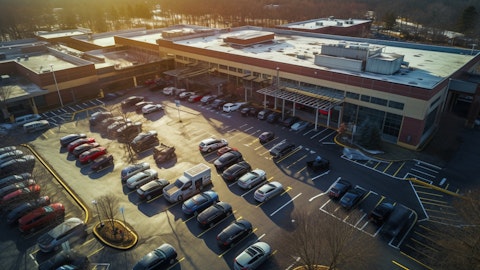Todd Meredith: Rich, I wouldn’t take this as some big signal. I think the bigger message here is that the JV idea as it has been in the past, but here with KKR is the idea to not only seed a portfolio that looks a lot like Healthcare Realty as a whole, but it’s also a go-forward investment vehicle that would continue to be a source of capital and diversifying our sources of capital and allowing us to continue to invest in those types of assets. And that’s a theme you’ve heard us for years talking about really making sure we have the right sources of capital to continue to invest in the types of assets we want to invest in. So this is part of that strategy. I wouldn’t read into it that we’re trying to lighten up or shift our exposure away.
In fact, it’s probably the opposite that we would continue to see our exposure to predominantly on adjacent to campus remaining consistent. Obviously, you’re right, at the margin, if you really do the math of 80-20 on the JV, maybe it tweaks it a little, but we would think, over time, that wouldn’t change materially for Healthcare Realty. So no big signal there just really part of seeing that disconnect in our public valuation versus private taking advantage of that in the near term and then long term, having another source of capital.
Richard Anderson: Okay. I know you’re targeting 6% to 6.5% on a leverage basis. I think the market would love a 5% handle eventually, perhaps you would too. With the additional asset sales that you’re looking to beyond the $600 million, would you think that a lot of that would still go toward buyback? Or would you might intermingle more in the way of deleveraging so that we can maybe test that sub-6% level at some point in the reasonable future?
Todd Meredith: Rich, I would say we’re very comfortable at 6.5% currently. I think what you’re talking about is a much longer-term view and not taking it away from you. But we’re focused on the near term of really driving FFO and FAD per share accretion and managing our leverage. So we think there’s a number of ways that it will naturally through operational improvements in NOI and EBITDA that it will naturally delever. But clearly, right now, we think the signal is repurchasing shares makes a lot of sense. So that’s what we’ll do. Obviously, as conditions evolve, we’ll continue to reevaluate it. But not signaling a difference in our view on leverage at this point.
Richard Anderson: Okay. Last for me. On the dividend, I know you’re — we’re going to grow into that in terms of the payout. Is there any part of the situation and in dividend policy that simply you can’t do like because of REIT guidelines, if you could just cut the dividend to get a better payout, but then you perhaps fall below that 90% threshold. Is that sort of intermingled into the strategy? Or are you nowhere near that number? And so that’s not really influencing the strategy?
Todd Meredith: Rich, I would say it’s not influencing the strategy. Obviously, we look at that every year and evaluate that, but that’s not in our thinking that that’s the concern. Our view is that we can grow into it. We think we can do that with operational improvements. It takes obviously a little longer by itself. And now when you add the transactions, the capital allocation priorities that we’ve talked about today, we can accelerate that. So it’s really a confidence that we can get there.
Operator: We now turn to John Pawlowski with Green Street.
John Pawlowski: I just have a few more questions on the quality of the properties and the $600 million pool of dispositions. Can you share is the — or maybe shorter way to ask it, average age of the properties and then kind of deferred CapEx profile, is it meaningfully better or worse than your portfolio average?
Todd Meredith: The average age is — I don’t have the average in front of me. But I would say, generally speaking, it’s a little bit of a newer vintage, if you will, but not some material change. But I think, generally speaking, a little newer. And on CapEx, I don’t have the percentage in front of me, but we would typically say it’s sort of in that similar range of a very stabilized portfolio. So more in that 15% range versus we’re spending currently a little bit more like last year, we were a little over 18%. Obviously, that had to do with absorption and spending more on tenant improvements, but more in that traditional stabilized range.
James Douglas: I don’t have the weighted average, but can give you a range of age. The oldest building was originally constructed in ’92 and the youngest was in 2017. So let’s say, generally consistent with the portfolio.
Todd Meredith: Most in the last 20 years, predominantly the last 20 years.
John Pawlowski: Okay. And then the remaining lease term, the walls on the $600 million, is it pretty close to the portfolio — your portfolio average?
Todd Meredith: It’s a little bit longer. It’s about 6 years versus we’re a little over 4 years on the KKR JV assets. It’s a little — it’s about 6 versus the overall portfolio being a little over 4 of remaining…
John Pawlowski: Okay. Final question from me. Still have about 35 properties in your — what you characterize as an unstabilized bucket. There’s been a lot of properties held over the last few years in this bucket. So just curious, what’s the appetite to sell these unstabilized properties? These properties are not generating nearly any NOI and then redeploying that capital elsewhere in the business?
James Douglas: Yes, that’s certainly something that we’re always looking at. And also, sometimes it just — it can be just a timing issue is that we’re now occupancy dropped off, and it’s been some time for us to release that back up. And we actually have that inside this portfolio already. We’ve got a significant amount. Just trying to count the number of properties, I would say, it’s probably half a dozen to a dozen properties that are already at 100% leased. And so it’s now just turning that lease percentage into occupancy and then converting it back. So I’d say it’s — overall, it’s a combination of our efforts that you see going on right now to drive absorption in some of those assets and in some places that — if it’s not a market that we’re looking to grow in long term or even a specific submarket or cluster that we could sell out of those assets as well.
But yes, long term, our goal and expectation is to drive the number of properties in that unstabilized portion of the portfolio much lower.
Operator: [Operator Instructions]. We now turn to Nikita Bely with JPMorgan.
Nikita Bely: The term med tail has been starting to come up more on conference calls recently in the retail world of medical retail, right? And is that something that you see is there’s some overlap with those properties, those kind of medical office and outpacing medical and the retail centers? Is there any similarity any overlap? Any impact that you’re seeing on your business maybe?
Todd Meredith: It’s a good question. I would say it’s not a new concept, but it is certainly a trend that has been underway for quite a while. We’ve looked at those types of properties to buy or even develop over the years, and we’re pretty selective about it. We tend to really try to focus more around the hospital and for more higher acuity services. What you tend to see in those med tail, medical retail locations, they’re very convenient. They tend to have fairly low acuity services. They’re very convenient for the consumer when they’re doing other things in the retail setting. And so we think there’s a lot of room for that. It’s certainly needed and good for the consumer, but it is generally not our target. We haven’t seen it be a big problem for what we’re trying to do, which is focus more on the higher acuity services that tend to be closer to the hospital in location.
Nikita Bely: Got it. And maybe any — on the development side, any new major developments or redevelopments that you’re planning to start over the next 12 months and maybe some return hurdles on those potential projects versus the ones that are already in process?
Todd Meredith: Sure. I’ll just comment that generally speaking, we have disclosure around our pipeline or in terms of our active projects. We are sensitive to the fact that starting new projects right now can be a dilutive initial exercise, even though the long-term returns might be very attractive. But our comment would be that we’re kind of pausing or cautious right now about starting new projects just for the moment, simply because we want to be mindful of that dilution effect in the near term. That said, we’re looking at JVs that could involve development projects, both existing projects as well as new. So we’re certainly looking at that as something we want to continue doing as an activity in creating shareholder value long term, but we’re mindful of sort of that near-term impact. In terms of return, Rob, I don’t know if you have any thoughts just in terms of — I don’t think it’s changed from what you’ve seen us disclose. But the — it’s ticked up a bit.
Robert Hull: Yes. I mean I think generally, it’s going to be dependent on how well leased it is and how much risk you’re taking. But in prior quarters and years, we’ve sort of used the 100 to 200 basis points above where we think similar stabilized assets are trading today. So if they’re in the mid-6s today, you’re probably looking in that 8% to 9% range on a new development, redevelopment certainly, certainly we target higher returns for that.
Operator: We have a follow-up question from Austin Wurschmidt with KeyBanc.
Austin Wurschmidt: Just another one on the asset sales. I guess, is the goal to sell some of the more stable assets into joint ventures or outright so that you can monetize that value? And I guess on the flip side, could we see any improvement in your same-store growth for either the single-tenant assets that you sold last quarter and the impact they have on single tenant growth and then kind of similarly for the multi-tenant assets that you announced this quarter?
Todd Meredith: Yes. Austin, I think you’re right at the margin that it makes sense to be selling and JVing stabilized assets simply because we’re looking at the assets we can really get that multi-tenant occupancy gain pushed through the company’s bottom line. And so that’s where we have a lot of optimism. Obviously, there are some that fall out of what Kris addressed earlier on the unstabilized properties where we may just say, “Hey, we don’t think we can drive occupancy there. We’ll go ahead and sell that.” But on the margin, I would say, you would see us JVing more — and selling more stabilized assets. And certainly, today in the market, financing is more conducive to those types of properties. That said, as I just mentioned, we would also look at potentially JVing some development projects, whether they’re existing projects or new projects.




